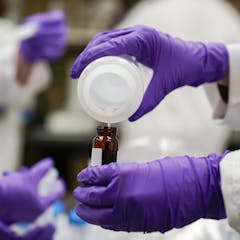
Articles sur Chemicals
Affichage de 1 à 20 de 82 articles

Filtering out PFAS is only the first step. These ‘forever chemicals’ still have to be destroyed, and there are many questions about how to do that safely.

These chemicals are now found on almost every part of the planet, including in the bodies of a large percentage of the American public. An environmental health scientist explains the risks.

Huge amounts of PFAS come from wastewater treatment plants, new study finds.

Herbicides and pesticides wash downriver from farms and towns – and some of these chemicals are taken up by oysters.

Chlorine is a widely used industrial chemical that’s frequently a factor in toxic accidents and workplace injuries. A pharmaceutical expert explains why it’s so hazardous.

Scientists found PFAS hot spots in Miami’s Biscayne Bay where the chemicals are entering coastal waters and reaching the ocean. Water samples point to some specific sources.

It’s not just the ingredients we should be concerned about. The devices themselves release chemicals that end up in our blood and urine.

New restrictions on PFAS and other potentially hazardous chemicals in Australia present an opportunity for industry to develop alternatives for new, safe and clean products.

How dangerous is borax? And what’s the best way to judge the toxicity of everyday household products?

Finding cosmetics that are free of hormone- disrupting chemicals often means paying more. An epidemiologist explains the risk, particularly for young women.

Quaternary ammonium compounds, also known as QACs or quats, are commonly used antimicrobials also found in many household products. Soap and water may be a safer bet when cleaning surfaces.

Manufacturers don’t usually have to disclose what’s in products like shampoo and household cleaners, but a new study finds that these products can contain hazardous ingredients.

Fracking for oil and gas uses millions of pounds of chemicals, some of which are toxic or carcinogenic. Two researchers summarize what companies have disclosed and call for more transparency.

The Biden administration is finalizing the first federal limits on two compounds, PFOA and PFOS, in drinking water. These so-called ‘forever chemicals’ have been linked to numerous health effects.

An environmental health lawyer explains why some states have weaker rules than others, and how you can make your concerns heard.

Transportation Secretary Pete Buttigieg is looking into new rules for trains. Trucks, however, are involved in thousands more hazmat incidents every year in the US.

Vinyl chloride dilutes fairly quickly in outside air and water. One concern for lingering exposure from the derailment involves private wells.

The slow release of information about the chemical spill and results of air and water tests have left many questions about the risks and long-term impact.

The WHO’s International Agency for Research on Cancer convenes a panel of scientific experts to review available evidence on whether specific chemicals or occupational exposures may cause cancer.

A wave of infrastructure projects is coming as federal funds pour in. Cities and everyone in them needs to know the risks from the cheapest, most popular repair method and how to avoid harm.
